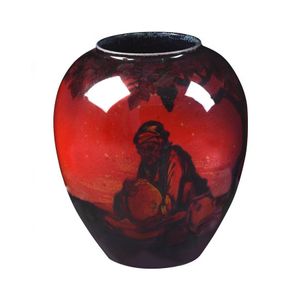Royal Doulton Bone China Fisherman Vase with Cover
You must be a subscriber, and be logged in to view price and dealer details.
Subscribe Now to view actual auction price for this item
When you subscribe, you have the option of setting the currency in which to display prices to $Au, $US, $NZ or Stg.
- Bone China - Bone china, Also called 'English china", is one of the three types of porcelain, the other two being soft paste porcelain and hard paste porcelain.
Porcelain is an ancient ceramic material, first made in China, hence the common name "china", and the introduction of bone china was to counter the imports of Chinese porcelain.
The initial development of bone china is credited to Josiah Spode, who introduced it around 1800 and it was soon after copied by other manufacturers including Minton, Coalport, Davenport, Derby, Worcester, Wedgwood and Rockingham and the Herculaneum factory at Liverpool.
Spode's bone china was made by mixing ash from cattle bones with feldspar and kaolin, which created a material that was stronger, more translucent, and whiter than traditional porcelain. He began to produce this new type of porcelain in 1796 and it quickly became very popular.
At the time, the process and ingredients were kept secret and were only known to a few manufacturers and were protected by patents.
In the 19th century, bone china became increasingly popular and was widely produced by many manufacturers in England. During this time, it was considered a luxury item and was often used to create fine dining sets and other decorative items.
Bone china is still used in the production of fine porcelain wares, such as tea sets, figurines, and other decorative pieces. His basic formula of six parts bone ash, four parts china stone, and three and a half parts china clay remains the standard English body. It is still considered a luxury item due to its strength, translucency, and whiteness, and is often used for high-end and high-quality porcelain. China.
This item has been included into following indexes:
- Johnson, Reg - Royal Doulton, designers 4
-
Royal Doulton (England), item types
- ovoid and baluster shaped vases 1,515
- vases, other 743
Visually similar items

A William Moorcroft vase, of squat circular form painted in the Claremont pattern, traditional deep red, blue and yellow highlighted tones on the green dominant ground painted signature in green and dated 10-1913 to base. Diameter 15.5 cm, height 6.7 cm

A large Carlton Ware Rouge Royale ginger jar, traditional ovoid form with polychrome enamel and elaborate gilt decoration of buildings, trees and figures on a striking red ground, printed mark to base. Lid absent. Height 21.6 cm

A Royal Doulton Sung flambe 'Middle Eastern' scene vase, circa 1920, By Charles Noke and Arthur Eaton, stamped and inscribed Royal Doulton England Sung Flambe Noke, 17 cm high

Moorcroft Anemone vase. Height 33 cm
